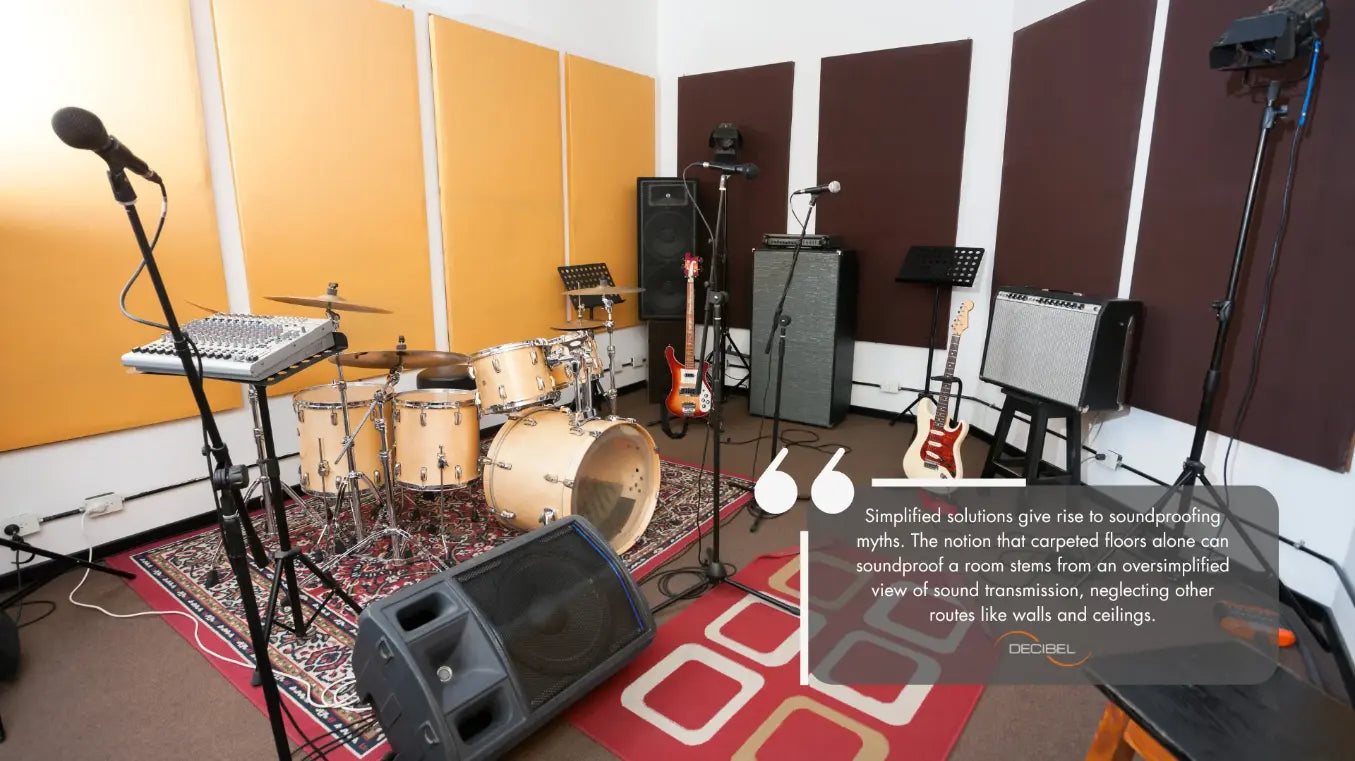
Top 10 Soundproofing Myths Busted
Tanya IlievaShare
📖 Reading time: 2 min and 33 sec
Soundproofing isn’t just about silencing a space—it’s about creating harmony and functionality in our noisy world. However, misconceptions about how to achieve it often leave people with subpar results. Whether you're trying to block noisy neighbours, create a serene home office, or improve a recording studio, understanding the truth behind common myths is key. In this updated guide, we’ll explore these misconceptions and dive into practical insights, such as why egg cartons don't work, the limits of soundproofing paint, and what truly makes a difference when tackling noise challenges. Let’s debunk the myths and get you closer to a quieter space.
Myth#1: Egg cartons are great for soundproofing
What’s the reality? Egg cartons, though cheap and easy to find, are only good at diffusing sound—not soundproofing. This myth likely stems from their appearance, which resembles professional acoustic foam. However, egg cartons lack the density required to block sound waves.
What works better? Dense materials like mass-loaded vinyl or specialised soundproofing panels effectively block sound transmission. For budget-friendly options, consider heavy curtains or bookshelves loaded with books against a noisy wall.
Myth#2: Soundproofing foam can completely drop all noise
Reality check: Foam is designed for acoustic treatment, not soundproofing. While it can reduce echo and improve room acoustics, it doesn’t prevent noise from entering or leaving a space.
A surprising example: If you’re in a home office trying to reduce street noise, foam panels won’t help much. Instead, soundproofing requires barriers that stop sound transfer, such as double drywall or decoupling techniques like resilient channels.
Myth#3: Closing windows and doors provides enough soundproofing
Why it’s a myth: While shutting windows and doors can reduce some sound, it doesn't address the major culprits: gaps and thin materials.
Did you know? Even a 1% open gap in a window frame can let in up to 30% of noise. A quick fix is using weatherstripping or acoustic sealant to seal leaks. For a bigger impact, opt for double-glazed windows.

Myth#4 Sealing off a room makes it soundproof
The facts: Total soundproofing is about more than just sealing gaps; it involves layering dense materials, isolating surfaces, and ensuring there’s no vibration transfer.
A useful tip: Many people overlook impact noise, like footsteps above. Installing underlayment or ceiling soundproofing materials can significantly reduce this.
Myth#5: Only expensive soundproofing materials work
Reality: While some professional-grade materials can be costly, there are many affordable ways to reduce noise. Heavy rugs, bookshelves, and even thick curtains can make a noticeable difference in noise levels.
Example: If you’re on a budget, layering inexpensive materials like foam mats under carpets or hanging moving blankets on walls can help cut noise without breaking the bank.

Myth#6: Soundproof paint can end noise issues
The truth: Soundproof paint provides a minor reduction in noise—around 3–5 decibels—which is far from sufficient for most soundproofing needs.
What’s better? Combine it with other strategies like installing acoustic panels or adding insulation to walls for meaningful noise reduction.
Myth#7: Adding carpet to floors will soundproof a room
Fact: Carpets are effective at reducing impact noise (like footsteps) but don’t block airborne noise such as voices or music.
Pro tip: For better results, use carpet alongside underlayment materials, which absorb vibrations and reduce noise transmission to lower floors.
Myth#8: You need to completely cut all sounds for effective soundproofing
Reality: The goal of soundproofing isn’t total silence but achieving a significant reduction in unwanted noise.
Example: In shared living spaces, eliminating 70–80% of noise often creates a big enough improvement to make daily life more comfortable.
Myth#9: Having a lot of thick-walled furniture will soundproof a room
Debunked: While furniture can absorb some sound waves, it doesn’t provide the density or mass required to block noise entirely.
Instead, try this: Combine furniture placement with soundproofing measures like sealing gaps and installing soundproofing wall panels for ultimate results.

Myth#10: Using white noise generators will soundproof a space
Truth: White noise machines mask unwanted sounds but don’t block them. This can be helpful for improving focus or sleep but isn’t a substitute for soundproofing.
Fun fact: White noise mimics the background hum we experience in nature, which is why it’s so soothing.
The Science Behind Effective Soundproofing
Soundproofing success lies in understanding the science of sound. At its core, sound travels in waves that move through air, solid objects, and even liquids. These waves are characterised by their frequency and amplitude—determining the pitch and loudness we hear. Addressing noise issues requires mitigating these vibrations, whether by absorbing, blocking, or isolating them.
Understanding the Science of Sound
Absorption is achieved using porous materials like acoustic foam or heavy fabrics, which capture sound energy and convert it to heat. Blocking, on the other hand, relies on dense, heavy materials that resist the transmission of sound waves, such as mass-loaded vinyl or thick drywall layers. Finally, isolation involves creating structural separations, like decoupled walls or floating floors, to interrupt the path of vibrations.
Did you know that low-frequency sounds, like a neighbour’s subwoofer, are particularly challenging to manage? These waves are longer and carry more energy, easily penetrating walls and floors. Addressing such issues often requires combining strategies, such as adding insulation, sealing gaps, and using decoupling systems.
The Role of Reverberation
Understanding the role of reverberation is equally important. Hard, flat surfaces, such as glass or concrete, reflect sound waves, amplifying noise within a room. Adding softer, uneven surfaces—like rugs, curtains, or furniture—reduces this echo effect, creating a more acoustically pleasant environment.
For homeowners battling noisy neighbours, tenants managing shared walls, or professionals designing quiet spaces, the interplay of these principles reveals the true art of soundproofing. By learning to manipulate how sound behaves in a space, you can achieve peace and quiet without relying on misleading shortcuts or ineffective methods. The journey to tranquillity begins with an appreciation of sound’s complexities and the informed application of these principles.
The (im)Possible Noise-Free World
Urban noise is getting louder. So, finding peaceful havens is more crucial. We've dispelled these widespread soundproofing myths. This has opened the door to a better way to create peaceful spaces.
The key to good sound management is understanding acoustics. It also involves disproving ideas that delay progress. With accurate knowledge, you can make good decisions. They are about changing your home. Remember, in soundproofing, the best symphony aligns with science.



